Remote Sensing of Suspended Sediment Concentrations Based on the Waveform Decomposition of Airborne LiDAR Bathymetry
Abstract
1. Introduction
2. Method
2.1. Parameters of the Volume Backscatter Return
2.2. Waveform Decomposition
2.3. Empirical Suspended Sediment Concentration (SSC) Models
2.4. Remote Sensing of SSCs Based on the Waveform Decomposition of Airborne LiDAR Bathymetry (ALB)
3. Experiment and Analysis
3.1. Data Acquisition
3.2. Building the SSC Models
3.3. Remote Sensing of SSCs
4. Discussion
5. Conclusions and Suggestions
Acknowledgments
Author Contributions
Conflicts of Interest
References
- Volpe, V.; Silvestri, S.; Marani, M. Remote sensing retrieval of suspended sediment concentration in shallow waters. Remote Sens. Environ. 2011, 115, 44–54. [Google Scholar] [CrossRef]
- Guillén, J.; Palanques, A.; Puig, P. Field calibration of optical sensors for measuring suspended sediment concentration in the western Mediterranean. Sci. Mar. 2000, 64, 427–435. [Google Scholar] [CrossRef]
- Montanher, O.C.; Novo, E.M.; Barbosa, C.C. Empirical models for estimating the suspended sediment concentration in Amazonian white water rivers using Landsat 5/TM. Int. J. Appl. Earth Obs. Geoinf. 2014, 29, 67–77. [Google Scholar] [CrossRef]
- Kim, M.; Feygels, V.; Kopilevich, Y.; Park, J.Y. Estimation of inherent optical properties from CZMIL lidar. In Proceedings of the SPIE Asia-Pacific Remote Sensing, Beijing, China, 13–16 October 2014; Volume 9262, p. 92620W. [Google Scholar]
- Curran, P.J.; Novo, E.M. The relationship between suspended sediment concentration and remotely sensed spectral radiance: A review. J. Coast. Res. 1998, 4, 351–368. [Google Scholar]
- Warrick, J.A.; Mertes, L.A.K.; Siegel, D.A.; Mackenzie, C. Estimating suspended sediment concentrations in turbid coastal waters of the Santa Barbara Channel with SeaWiFS. Int. J. Remote Sens. 2004, 25, 1995–2002. [Google Scholar] [CrossRef]
- Binding, C.E.; Bowers, D.G.; Mitchelson-Jacob, E.G. Estimating suspended sediment concentrations from ocean colour measurements in moderately turbid waters; the impact of variable particle scattering properties. Remote Sens. Environ. 2005, 94, 373–383. [Google Scholar] [CrossRef]
- Wang, J.J.; Lu, X.X. Estimation of suspended sediment concentrations using Terra MODIS: An example from the Lower Yangtze River, China. Sci. Total Environ. 2010, 408, 1131–1138. [Google Scholar] [CrossRef] [PubMed]
- Giardino, C.; Bresciani, M.; Valentini, E.; Gasperini, L.; Bolpagni, R.; Brando, V.E. Airborne hyperspectral data to assess suspended particulate matter and aquatic vegetation in a shallow and turbid lake. Remote Sens. Environ. 2015, 157, 48–57. [Google Scholar] [CrossRef]
- Gao, J. Bathymetric mapping by means of remote sensing: Methods, accuracy and limitations. Prog. Phys. Geogr. 2009, 33, 103–116. [Google Scholar] [CrossRef]
- Guenther, G.C.; Cunningham, A.G.; Laroque, P.E.; Reid, D.J. Meeting the accuracy challenge in airborne Lidar bathymetry. In Proceedings of the 20th EARSeL Symposium: Workshop on Lidar Remote Sensing of Land and Sea, Dresden, Germany, 16–17 June 2000. [Google Scholar]
- Zhao, J.; Zhao, X.; Zhang, H.; Zhou, F. Shallow Water Measurements Using a Single Green Laser Corrected by Building a Near Water Surface Penetration Model. Remote Sens. 2017, 9, 426. [Google Scholar] [CrossRef]
- Zhao, J.; Zhao, X.; Zhang, H.; Zhou, F. Improved Model for Depth Bias Correction in Airborne LiDAR Bathymetry Systems. Remote Sens. 2017, 9, 710. [Google Scholar] [CrossRef]
- Wong, H.; Antoniou, A. Characterization and decomposition of waveforms for LARSEN 500 airborne system. IEEE Trans. Geosci. Remote Sens. 1991, 29, 912–921. [Google Scholar] [CrossRef]
- Allocca, D.; London, M.; Curran, T.; Concannon, B.; Contarino, V.M.; Prentice, J.; Kane, T.J. Ocean water clarity measurement using shipboard lidar systems. Proc. SPIE 2002, 4488, 106–114. [Google Scholar]
- Richter, K.; Maas, H.G.; Westfeld, P.; Weiß, R. An Approach to Determining Turbidity and Correcting for Signal Attenuation in Airborne Lidar Bathymetry. PFG–J. Photogramm. Remote Sens. Geoinf. Sci. 2017, 85, 31–40. [Google Scholar] [CrossRef]
- Saylam, K.; Brown, R.A.; Hupp, J.R. Assessment of depth and turbidity with airborne Lidar bathymetry and multiband satellite imagery in shallow water bodies of the Alaskan North Slope. Int. J. Appl. Earth Obs. Geoinf. 2017, 58, 191–200. [Google Scholar] [CrossRef]
- Billard, B.; Abbot, R.H.; Penny, M.F. Airborne estimation of sea turbidity parameters from the WRELADS laser airborne depth sounder. Appl. Opt. 1986, 25, 2080–2088. [Google Scholar] [CrossRef] [PubMed]
- Philips, D.M.; Abbot, R.H.; Penny, M.F. Remote sensing of sea water turbidity with an airborne laser system. J. Phys. D Appl. Phys. 1984, 17, 1749. [Google Scholar] [CrossRef]
- Collin, A.; Archambault, P.; Long, B. Mapping the shallow water seabed habitat with the SHOALS. IEEE Trans. Geosci. Remote Sens. 2008, 46, 2947–2955. [Google Scholar] [CrossRef]
- Feygels, V.I.; Wright, C.W.; Kopilevich, Y.I.; Surkov, A.I. Narrow-field-of-view bathymetrical lidar: Theory and field test. In Ocean Remote Sensing and Imaging II, Proceedings of the Optical Science and Technology, SPIE'S 48th Annual Meeting, San Diego, CA, USA, 3–8 August 2003; SPIE: Bellingham, WA, USA, 2003; Volume 5155, pp. 1–12. [Google Scholar]
- Feygels, V.I.; Kopilevich, Y.I.; Surkov, A.I. Airborne lidar system with variable-field-of-view receiver for water optical properties measurement. In Ocean Remote Sensing and Imaging II, Proceedings of the Optical Science and Technology, SPIE'S 48th Annual Meeting, San Diego, CA, USA, 3–8 August 2003; SPIE: Bellingham, WA, USA, 2003; Volume 5155, pp. 12–22. [Google Scholar]
- Guenther, G.C. Digital Elevation Model Technologies and Applications: The DEM User’s Manual; ASPRS Publications: Annapolis, MD, USA, 2007; pp. 253–320. [Google Scholar]
- Steinvall, O.K.; Koppari, K.R.; Karlsson, U.C. Experimental evaluation of an airborne depth-sounding lidar. In Lidar for Remote Sensing, Proceedings of the Environmental Sensing ’92, Berlin, Germany, 15–19 June 1992; SPIE: Bellingham, WA, USA, 1992; Volume 1714, pp. 108–127. [Google Scholar]
- Fuchs, E.; Tuell, G. Conceptual design of the CZMIL data acquisition system (DAS): Integrating a new bathymetric lidar with a commercial spectrometer and metric camera for coastal mapping applications. In Proceedings of the SPIE Defense, Security, and Sensing, Orlando, FL, USA, 5–9 April 2010; Society of Photo-Optical Instrumentation Engineers (SPIE): Bellingham, WA, USA, 2010. [Google Scholar]
- Guenther, G.C. Airborne Laser Hydrography: System Design and Performance Factors. Available online: http://shoals.sam.usace.army.mil/downloads/Publications/AirborneLidarHydrography.pdf (accessed on 25 February 2017).
- Tuell, G.; Barbor, K.; Wozencraft, J. Overview of the coastal zone mapping and imaging LiDAR (CZMIL): A new multi-sensor airborne mapping system for the US Army Corps of Engineers. In Algorithms Technol. Multispectral, Hyperspectral, Ultraspectral Imagery XVI, Proceedings of the SPIE Defense, Security, and Sensing, Orlando, FL, USA, 5–9 April 2010; SPIE: Bellingham, WA, USA, 2010; Volume 7695, p. 76950R. [Google Scholar]
- Hofton, M.A.; Minster, J.B.; Blair, J.B. Decomposition of laser altimeter waveforms. IEEE Trans. Geosci. Remote Sens. 2000, 38, 1989–1996. [Google Scholar] [CrossRef]
- Wagner, W.; Ullrich, A.; Ducic, V.; Melzer, T.; Studnicka, N. Gaussian decomposition and calibration of a novel small-footprint full-waveform digitising airborne laser scanner. ISPRS J. Photogramm. Remote Sens. 2006, 60, 100–112. [Google Scholar] [CrossRef]
- Wang, C.; Li, Q.; Liu, Y.; Wu, G.; Liu, P.; Ding, X. A comparison of waveform processing algorithms for single-wavelength LiDAR bathymetry. ISPRS J. Photogramm. Remote Sens. 2015, 101, 22–35. [Google Scholar] [CrossRef]
- Abdallah, H.; Bailly, J.S.; Baghdadi, N.N.; Saint-Geours, N.; Fabre, F. Potential of space-borne LiDAR sensors for global bathymetry in coastal and inland waters. IEEE J. Sel. Top. Appl. Earth Obs. Remote Sens. 2013, 6, 202–216. [Google Scholar] [CrossRef]
- Abady, L.; Bailly, J.S.; Baghdadi, N. Assessment of quadrilateral fitting of the water column contribution in lidar waveforms on bathymetry estimates. IEEE Geosci. Remote Sens. Lett. 2014, 11, 813–817. [Google Scholar] [CrossRef]
- Abdallah, H.; Baghdadi, N.; Bailly, J.S. Wa-LiD: A new LiDAR simulator for waters. IEEE Geosci. Remote Sens. Lett. 2012, 9, 744–748. [Google Scholar] [CrossRef]
- Schwarz, R.; Pfeifer, N.; Pfennigbauer, M.; Ullrich, A. Exponential Decomposition with Implicit Deconvolution of Lidar Backscatter from the Water Column. PFG–J. Photogramm. Remote Sens. Geoinf. Sci. 2017, 85, 159–167. [Google Scholar] [CrossRef]
- Marquardt, D.W. An algorithm for least-squares estimation of nonlinear parameters. J. Soc. Ind. Appl. Math. 1963, 11, 431–441. [Google Scholar] [CrossRef]
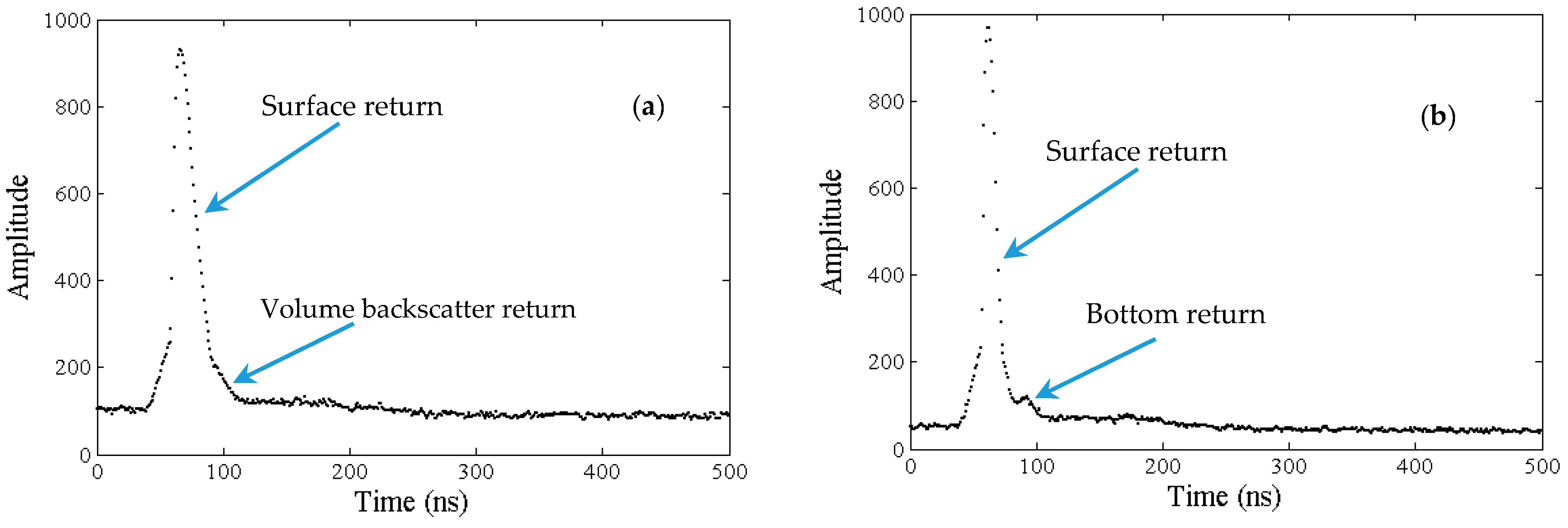
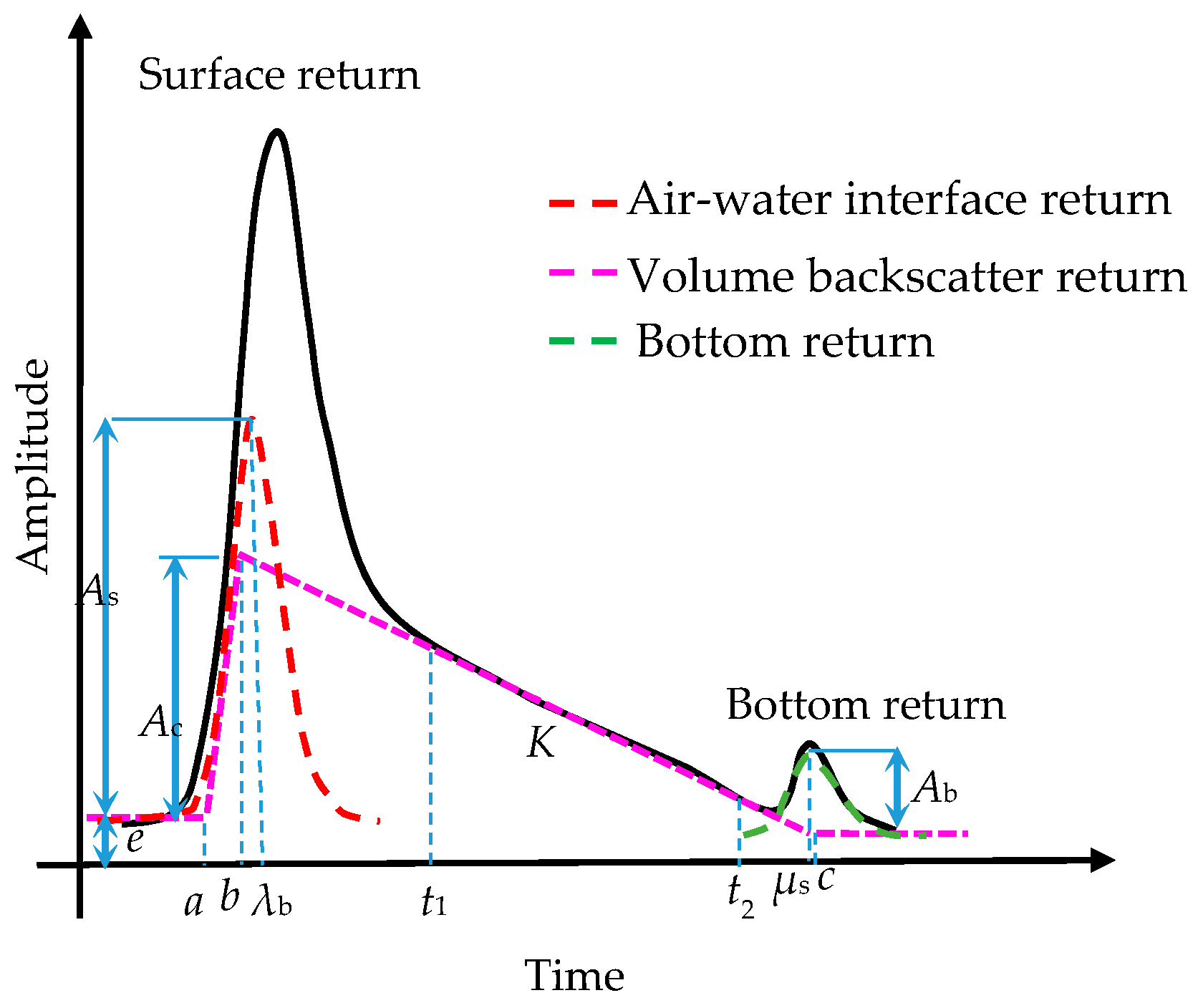
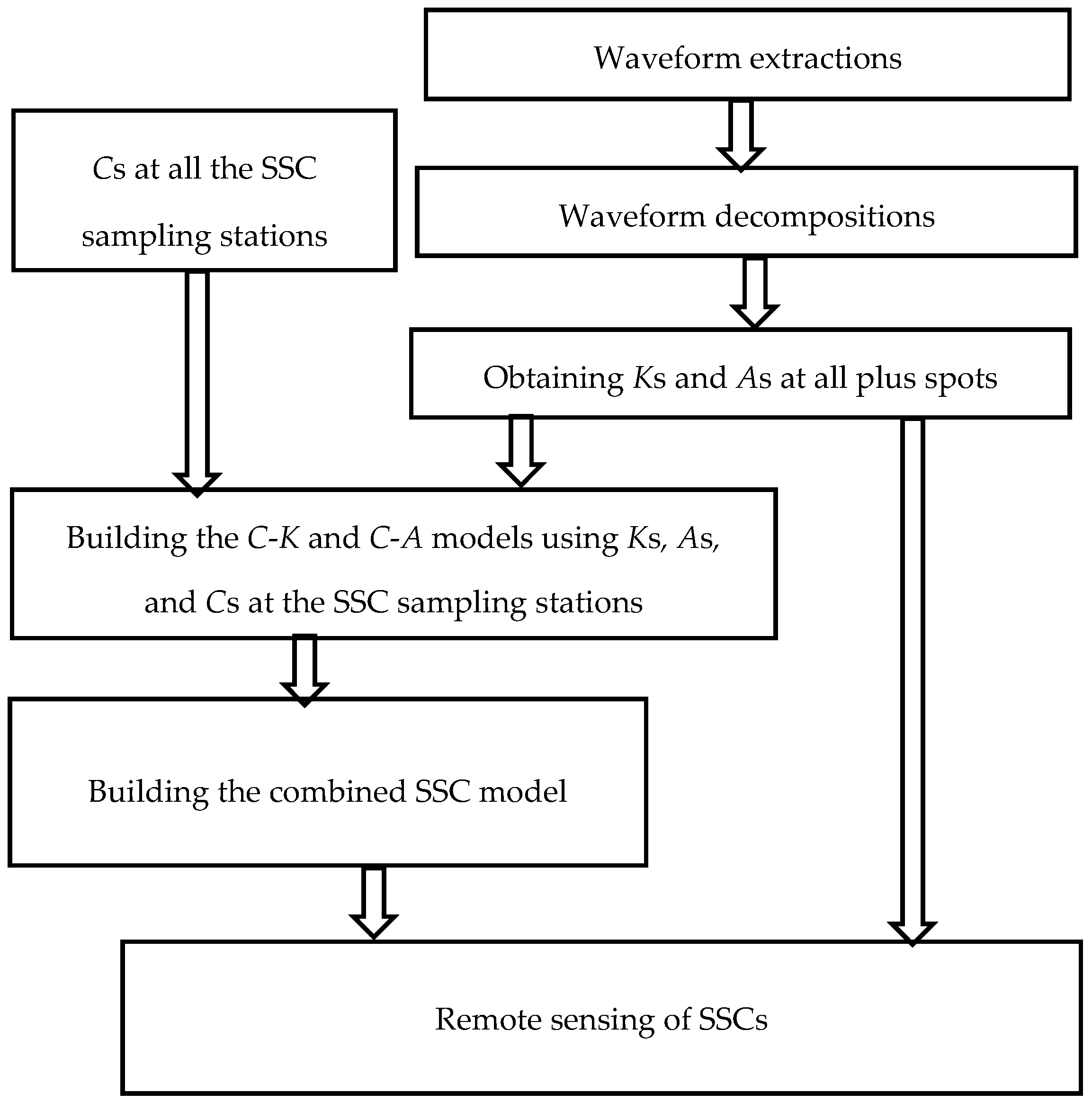
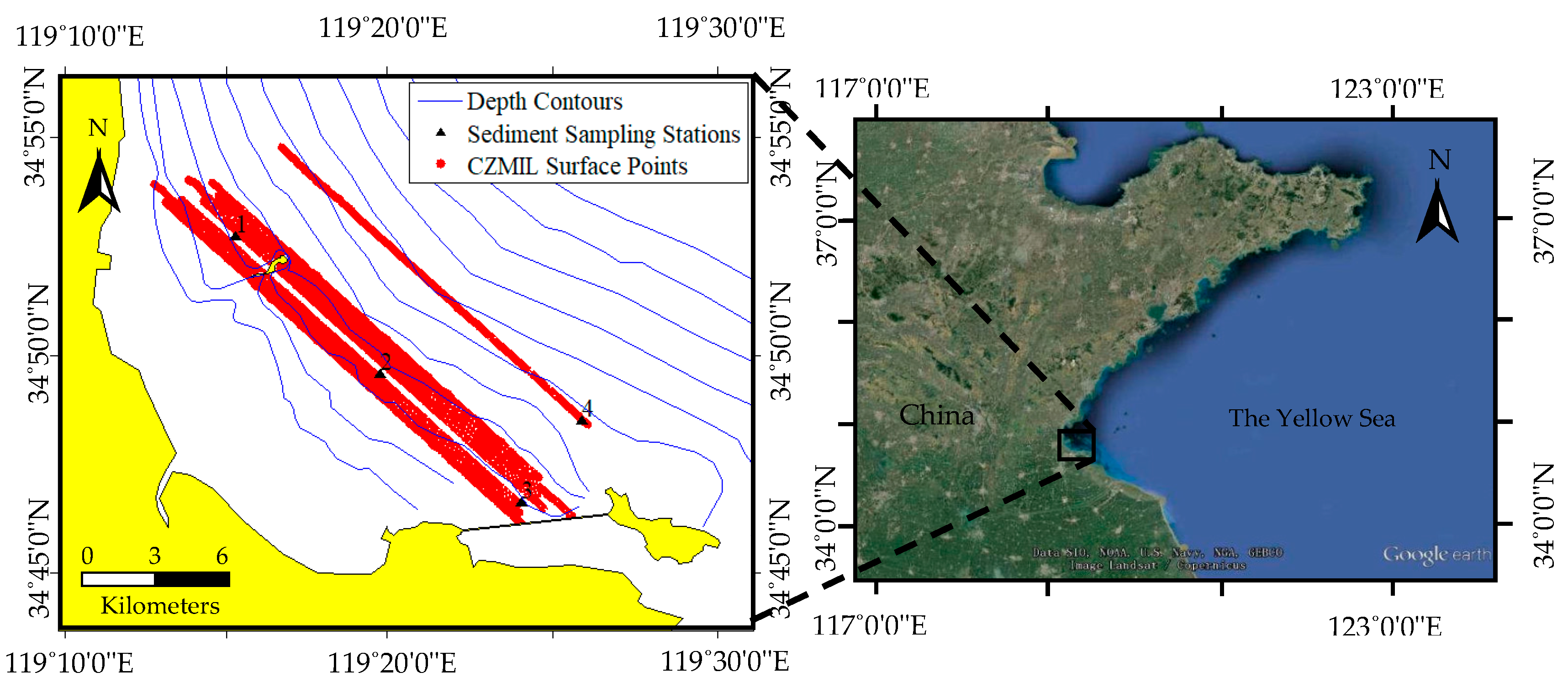
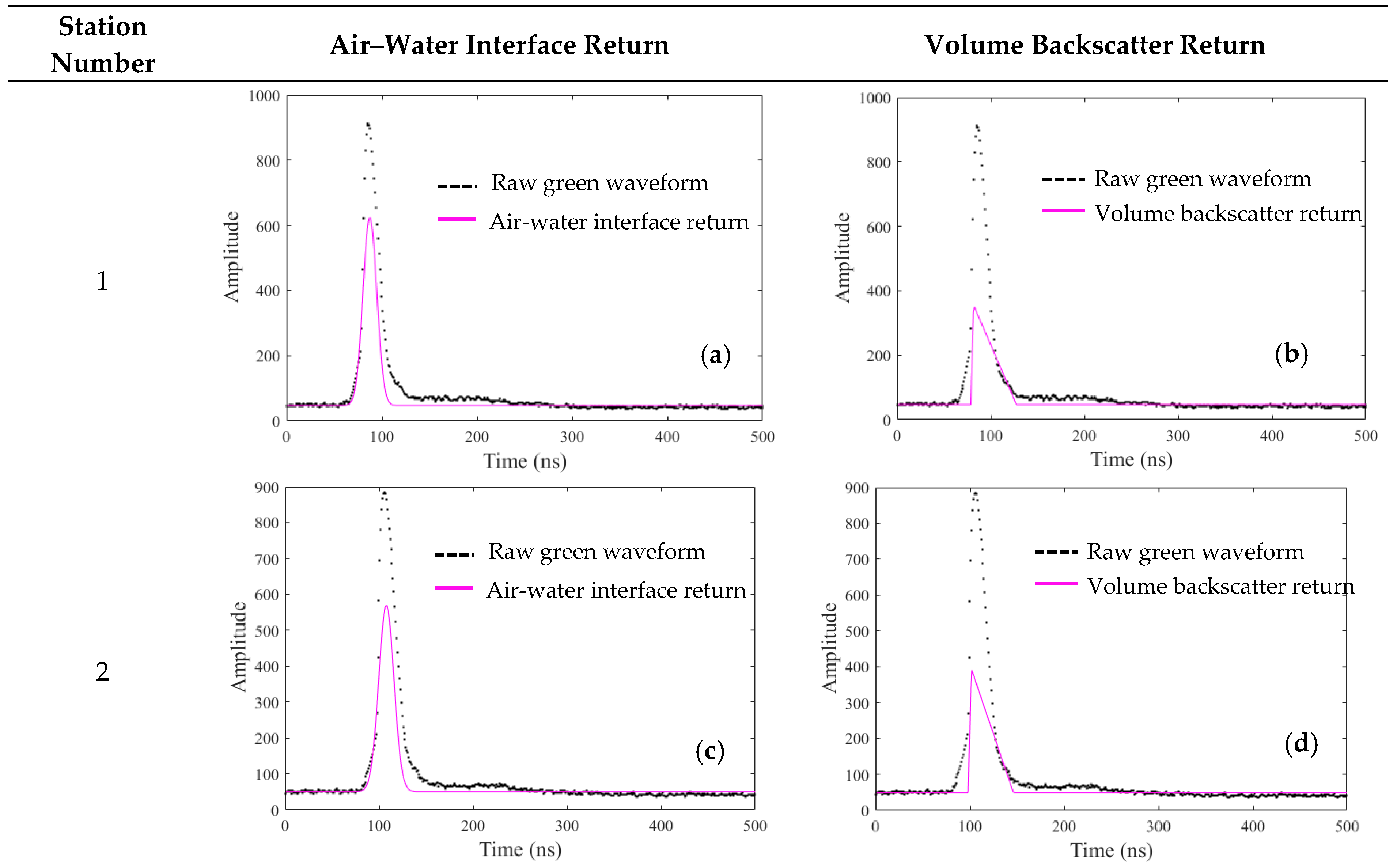
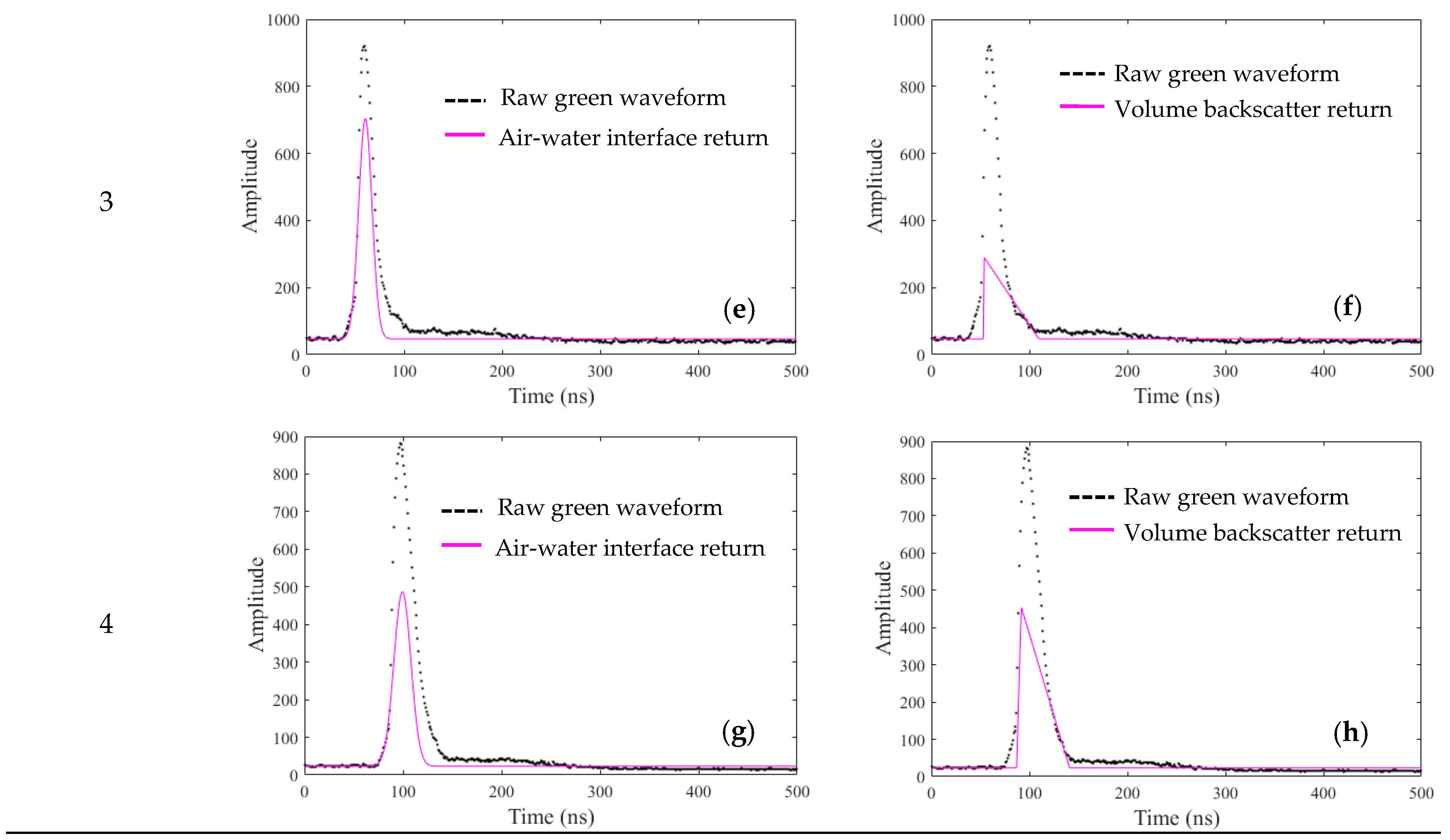
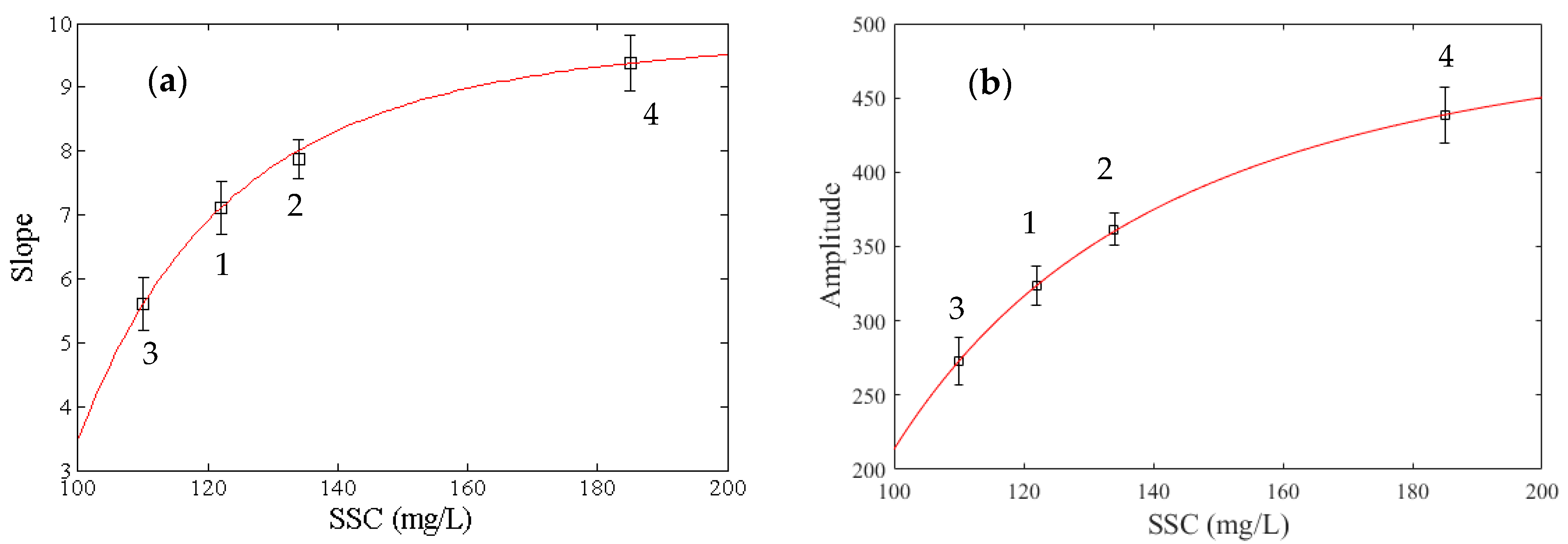
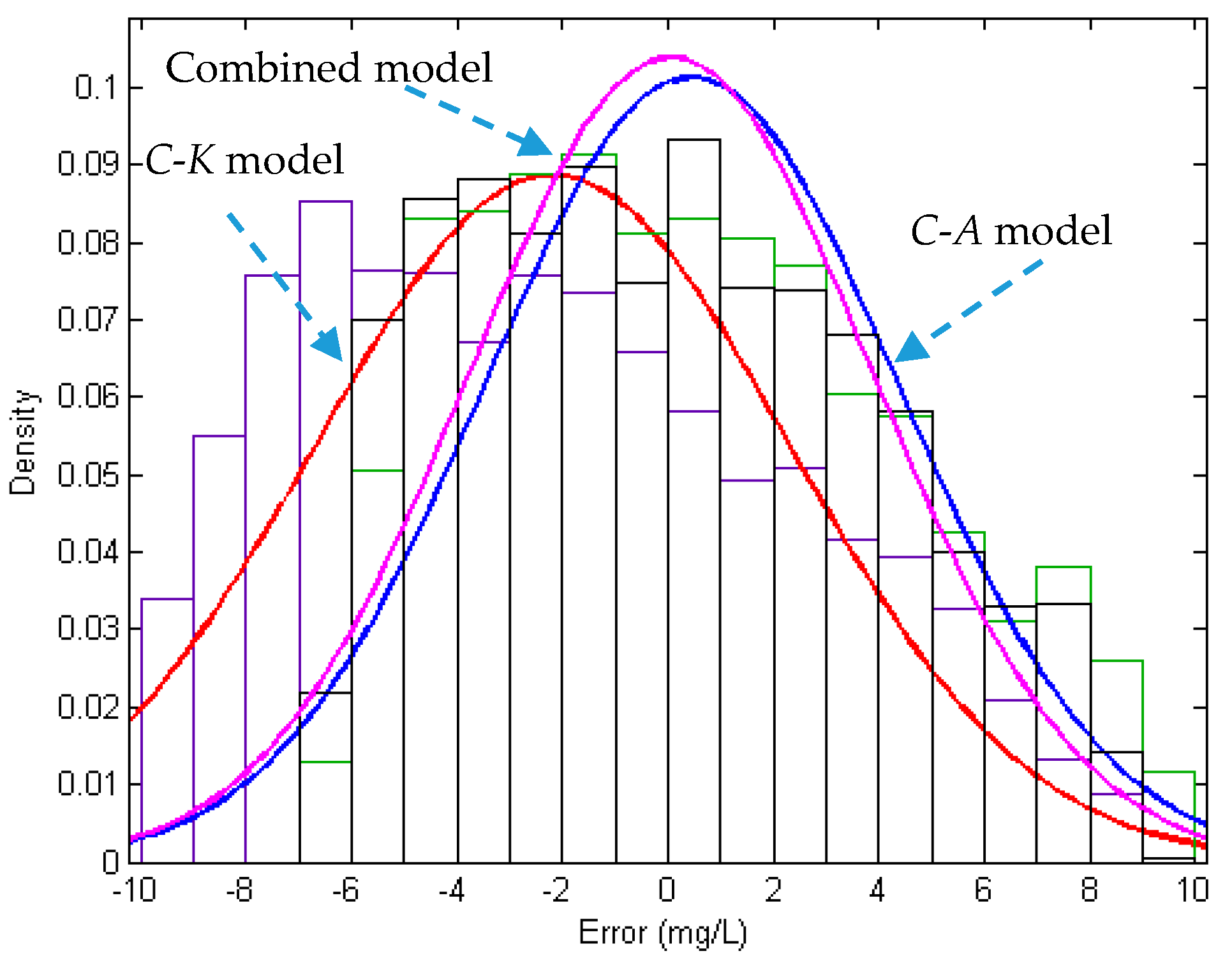
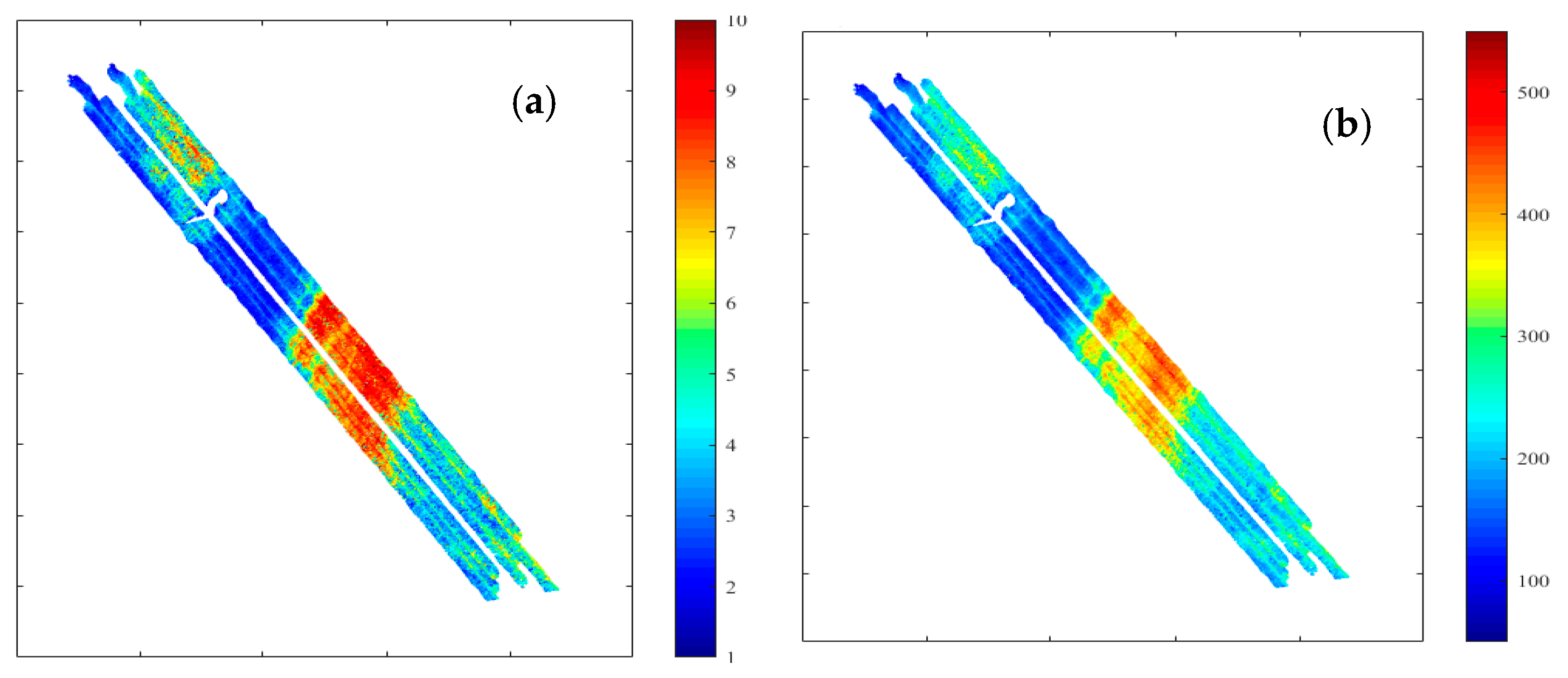
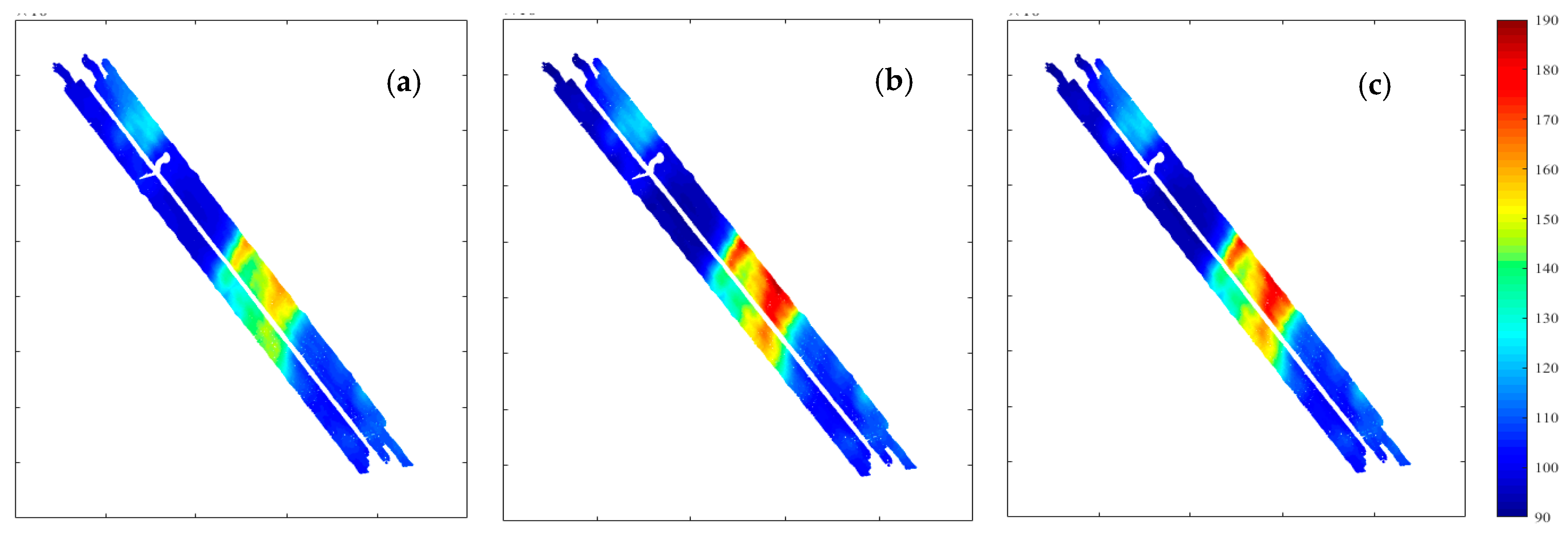
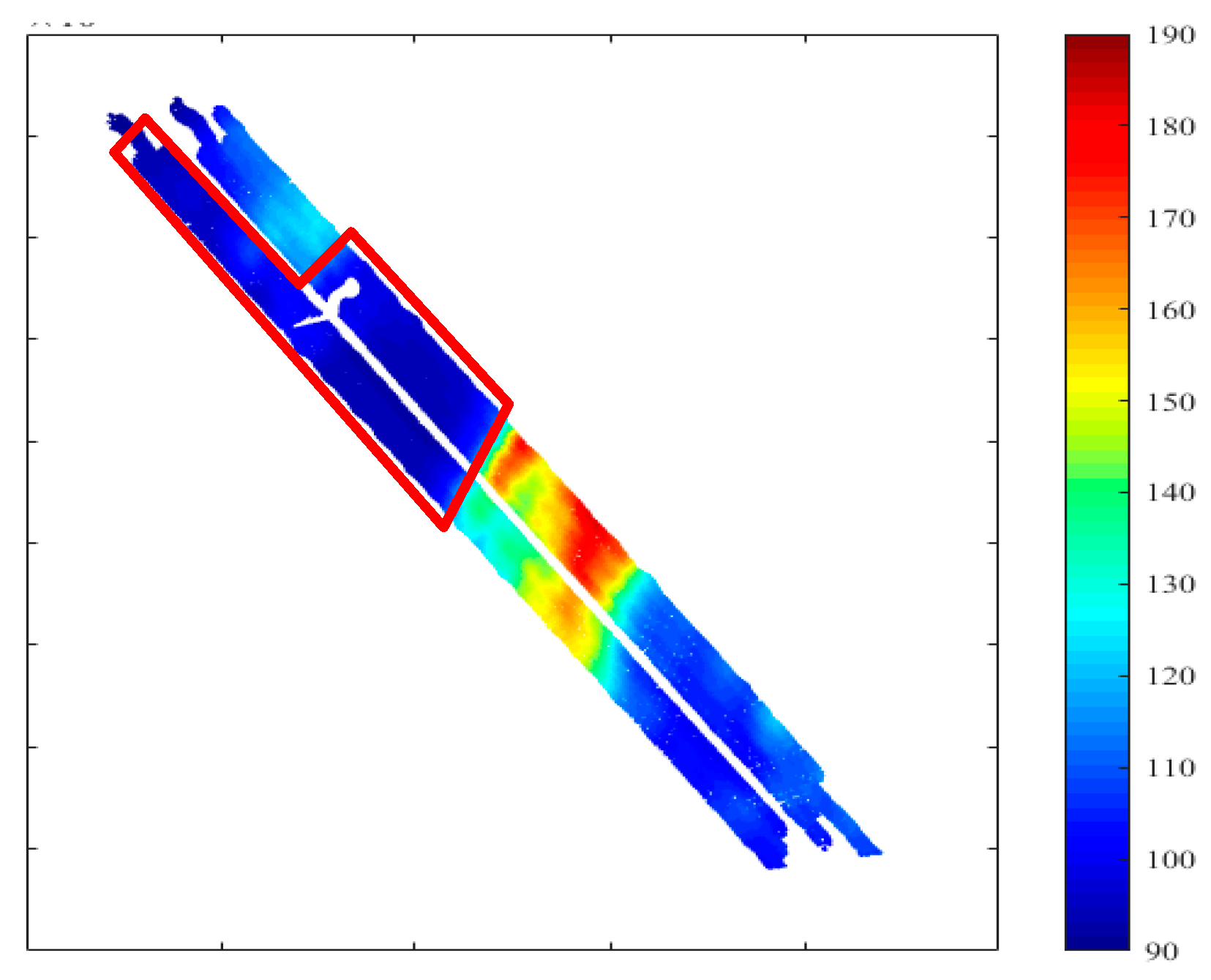

| Performance Index | Parameter |
|---|---|
| Operating altitude | 400 m (nominal) |
| Pulse repetition frequency | 10 kHz |
| Circular scan rate | 27 Hz |
| Laser wavelength | IR: 1064 nm; green: 532 nm |
| Maximum depth single pulse | Kd·Dmax = 3.75−4.0 daytime (bottom reflectivity >15%) |
| Minimum depth | <0.15 m |
| Depth accuracy | (0.32 + (0.013 depth)²)½ m, 2σ |
| Sounding scope | 0–30 m |
| Horizontal accuracy | (3.5 + 0.05 depth) m, 2σ |
| Scan angle | 20° (fixed off-nadir, circular pattern) |
| Swath width | 294 m (nominal) |
| Station Number | SSC (mg/L) |
|---|---|
| 1 | 122 |
| 2 | 134 |
| 3 | 110 |
| 4 | 185 |
| Station Number | Pulse Numbers | Max. | Min. | Mean | SD |
|---|---|---|---|---|---|
| 1 | 1387 | 36 | −38 | –0.6 | 20.5 |
| 2 | 1044 | 25 | −32 | 0.6 | 17.2 |
| 3 | 1885 | 34 | −31 | −0.4 | 16.7 |
| 4 | 1695 | 29 | −36 | −0.2 | 16.8 |
| Station Number | Slope | Amplitude | ||||||
|---|---|---|---|---|---|---|---|---|
| Max. | Min. | Mean | SD | Max. | Min. | Mean | SD | |
| 1 | 7.99 | 6.26 | 7.11 | 0.42 | 350 | 300 | 324 | 13.4 |
| 2 | 8.43 | 7.31 | 7.87 | 0.30 | 382 | 342 | 361 | 10.7 |
| 3 | 6.45 | 4.64 | 5.60 | 0.42 | 300 | 232 | 273 | 16.1 |
| 4 | 9.44 | 8.49 | 9.38 | 0.43 | 480 | 397 | 439 | 18.8 |
| C-K Model | C-A Model | ||||||
|---|---|---|---|---|---|---|---|
| a1 | b1 | c1 | R2 | a2 | b2 | c2 | R2 |
| −2.136 × 109 | −4.263 | 9.839 | 0.86 | −1.556 × 107 | −2.362 | 507.4 | 0.89 |
| Max. (mg/L) | Min. (mg/L) | Mean (mg/L) | SD (mg/L) | |
|---|---|---|---|---|
| C-K model | 8.5 | −9.8 | −2.20 | 4.5 |
| C-A model | 9.5 | −6.3 | 0.44 | 3.9 |
| Combined model | 9.0 | −6.6 | 0.05 | 3.8 |
© 2018 by the authors. Licensee MDPI, Basel, Switzerland. This article is an open access article distributed under the terms and conditions of the Creative Commons Attribution (CC BY) license (http://creativecommons.org/licenses/by/4.0/).
Share and Cite
Zhao, X.; Zhao, J.; Zhang, H.; Zhou, F. Remote Sensing of Suspended Sediment Concentrations Based on the Waveform Decomposition of Airborne LiDAR Bathymetry. Remote Sens. 2018, 10, 247. https://doi.org/10.3390/rs10020247
Zhao X, Zhao J, Zhang H, Zhou F. Remote Sensing of Suspended Sediment Concentrations Based on the Waveform Decomposition of Airborne LiDAR Bathymetry. Remote Sensing. 2018; 10(2):247. https://doi.org/10.3390/rs10020247
Chicago/Turabian StyleZhao, Xinglei, Jianhu Zhao, Hongmei Zhang, and Fengnian Zhou. 2018. "Remote Sensing of Suspended Sediment Concentrations Based on the Waveform Decomposition of Airborne LiDAR Bathymetry" Remote Sensing 10, no. 2: 247. https://doi.org/10.3390/rs10020247
APA StyleZhao, X., Zhao, J., Zhang, H., & Zhou, F. (2018). Remote Sensing of Suspended Sediment Concentrations Based on the Waveform Decomposition of Airborne LiDAR Bathymetry. Remote Sensing, 10(2), 247. https://doi.org/10.3390/rs10020247





